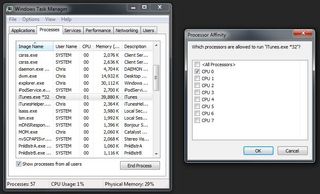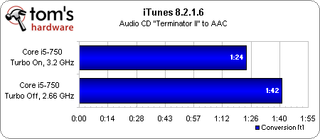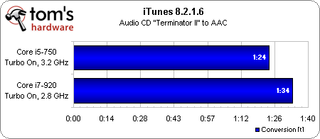Intel Core i5 And Core i7: Intel’s Mainstream Magnum Opus
Intel’s Turbo Boost: Lynnfield Gets Afterburners
The integrated PCI Express, two-channel memory controller, and tweaked QPI link are notable changes from Bloomfield to Lynnfield, but none are as story-altering as Intel’s latest version of Turbo Boost technology.
You’ll remember from our Bloomfield analysis that Core i7-900-series CPUs feature a PCU (power control unit), an on-die controller with approximately the same number of transistors as a complete 486 processor. At regular intervals, the PCU samples temperature, current, power consumption, and operating system states.
What does it do with this information? In the case of Bloomfield, which has a 130W TDP, the processor can almost completely shut off cores that are not in use by dropping them into C6, cutting consumption. Obviously, idle cores (those in C3 or C6) result in a larger gap between actual power use and the imposed maximum. So, in threaded workloads, where three or four of Bloomfield’s cores are working (but still under the PCU’s programmed limits), this feature called Turbo Boost increments the CPU’s clock ratio by one. Multiplied by a 133 MHz base clock, that’s an additional 133 MHz of free clock rate. With only one core active (in C0 or C1), Turbo Boost could take things up a second performance bin, adding 266 MHz to the chip’s standard clock.
Now, back when the Core i7-975 Extreme launched, I observed that it was actually very rare to see two bins of Turbo Boost in practice, since Vista’s scheduler has a bad habit of bouncing threads from one core to another, keeping multiple cores in action. I was able to screenshot the 975 running at 3.6 GHz, but it only lasted a fraction of a second. In that case, two bins wouldn't be what I’d consider a tangible benefit.
Fast forward to today. All three Core i5 and Core i7 CPUs now sport a 95W TDP (and an 89A ceiling), making the PCU’s power-policing duties even more critical. Adding further to the controller’s role is a more aggressive implementation of Turbo Boost. With three or four cores active, the Core i5-750 and Core i7-860 get a one-bin improvement each (the Core i7-870 gets two). But with only two cores active, all three models enjoy a four-bin (533 MHz) speed-up. And with one core active, the two Core i7s get five bins (667 MHz) so long as you’re still under 95W.
| Turbo Boost: Available Bins (Under TDP/A/Temp) | |||||
|---|---|---|---|---|---|
| Processor Number | Frequency | 4 Cores Active | 3 Cores Active | 2 Cores Active | 1 Core Active |
| Core i7-870 | 2.93 GHz | 2 | 2 | 4 | 5 |
| Core i7-860 | 2.8 GHz | 1 | 1 | 4 | 5 |
| Core i5-750 | 2.66 GHz | 1 | 1 | 4 | 4 |
| Core i7-975 | 3.33 GHz | 1 | 1 | 1 | 2 |
| Core i7-950 | 3.06 GHz | 1 | 1 | 1 | 2 |
| Core i7-920 | 2.66 GHz | 1 | 1 | 1 | 2 |
At the end of the day, this is really the legacy of Lynnfield. In threaded environments, you see the benefit of a quad-core processor. In titles like WinZip, Lame, or iTunes—benchmarks we’ve seen time and time again favor higher-clocked dual-core chips—Lynnfield kicks into gear to serve up better single-threaded speed.
In order to keep an even closer handle on consumption, the sampling rate of Lynnfield’s PCU is increased versus Bloomfield. Consequently, the new Core i5 and Core i7 processors can ramp voltage up or bring it back down more aggressively than Bloomfield-based CPUs, and thus react faster to a given single- or multi-threaded workload. It’s all fine-tuning really, but when you’re talking about switching between idle and active states, every little bit counts.
Stay on the Cutting Edge
Join the experts who read Tom's Hardware for the inside track on enthusiast PC tech news — and have for over 25 years. We'll send breaking news and in-depth reviews of CPUs, GPUs, AI, maker hardware and more straight to your inbox.


Testing Turbo
It’s actually really easy to see Turbo Boost in action, thanks to the TMonitor beta at cpuid.com. By simply assigning an application to a single processor core through Windows’ Task Manager, it’ll be constrained to that one CPU, realizing as much Turbo Boost acceleration as is available. Incidentally, this isn’t the best way to actually use a Core i5- or Core i7-based machine, as we realized better performance by default (even though iTunes looks to be jumping around between available cores).



As you might expect from a technology that can “overclock” a Core i5-750 from 2.66 GHz to 3.2 GHz in single-threaded workloads, the performance potential is significant. Our upcoming benchmarks compare the new i5 and i7 processors against Bloomfield, Yorkfield, and AMD’s Deneb, but here you’ll see i5-750 with Turbo on and off under iTunes.

The result is compelling, especially when you look at how the i5 does against the rest of the pack.

Put the i5-750 ($199) up against the i7-920 ($279-ish) in single-threaded apps and you get even more interesting results. Turbo Boost is the “killer app” that’s going to allow these Lynnfield processors to beat out more expensive Bloomfield configurations in the right environments.
Core i7 Coming Up Short With One Core Active?
In trying to get the very most out of Turbo Boost, we did observe some interesting behavior with single-core scenarios. The Core i5-750 had no trouble realizing its four-bin boost, jumping from 2.66 GHz to 3.2 GHz in a number of workloads.


However, as we observed in our Core i7-975 Extreme review, the Core i7-870 and Core i7-920 failed to reach their 3.6 GHz and 2.93 GHz peaks, respectively, unless you force the running program into a single core manually.
Now, according to Intel, most applications that report clock rates rely on ACPI-based P-states, and are thus unable to correctly detect frequencies modified by Turbo Boost. But we’ve been assured that TMonitor does properly reflect the actual frequency on a per-core basis. Consequently, it’s more accurate to think of the Core i7-800s as receiving four bins with one core active and the Core i7-900s as getting one extra bin, rather than counting on five and two bins, respectively.
Current page: Intel’s Turbo Boost: Lynnfield Gets Afterburners
Prev Page QPI, Integrated Memory, PCI Express, And LGA 1156 Next Page Hyper-Threading: Differentiating Core i7-
caamsa Dang! AMD better get their $4iT together. Now I need to decided between i7, i5 or phenom II when I do my next upgrade........technology happens too fast. Looking forward to more reviews on the i5 and mb prices.Reply -
People need to be careful when comparing the i7-870 to a i7-920, alot of people pre-release were worried that the 1156 platform was going to dominate the 1366. However when you see the 870 out perform the 920 people need to remember that a 870 is double the price of a 920, and even when you factor in a motherboard a 920 setup comes out cheaper than a 870.Reply
Now the i5 750 on the other hand is great performance at a great price, and would certainly be the budget gamers new weapon of choice.
I currently have an i7-920 setup which is my main rig and am very happy with it and not at all upset to the see the 870 outperform it (since the 870 would cost me twice as much). I also have had an i5 750 setup now for over a week (the 1156 processors and motherboards have been available here in Australia for nearly 2 weeks now) and it is an amazing processor for the price of it.
So what am I trying to say? 1366 is still a good platform for the top end of the market. The i5 are fantastic new processors for their price, and the 1156 i7's are just confusing and I'm not really sure who they are going to appeal to? I could understand it if Intel launched the 1156 i7's in 6months time when alot of users are already using the 1156 platform and are looking to upgrade their CPU without a new mobo. But to anyone looking at getting a 870, just get an 920 and use the extra cash on the mobo and ram to go with it. -
Nintendork A little confusing the charts.Reply
I would prefer a bench with HD4890. They scale better in CF. -
cabose369 Intel needs to come up with a simplified naming system for their products. They are as bad as NVIDIA is right now in terms of naming their products.Reply
There is sooo much to learn and there is so much information here.... I feel confused!! -
alikum Well, I just hope that the Core 2 Quads will drop in prices significantly so that I could grab the high-end one for my final LGA775 upgrade!Reply -
buzznut Well this is good news for consumers. I'm not certain why it took so long for Intel to make some mainstream proc like i5, but for intel fans it seems worth the wait.Reply
This will also compel AMD to bring some more value to the market. Nice article. -
jawshoeaw damn, 150 watts at idle?? Is that just the cpu? I hope the gaming rigs built on these processors are not left on 24/7. My old AMD X2 3800 system including the monitor uses less than 150 watts at idle (50 of which is the 22" LCD).Reply -
unclewebb i7 Turbo is a good tool to monitor the multiplier of Core i5/i7 CPUs.Reply
http://www.fileden.com/files/2008/3/3/1794507/Turbo.zip
It uses the method that Intel recommends in their November 2008 Turbo White Paper. -
evolve60 "Intel Core i7-920 Extreme (Bloomfield) 2.66 GHz, LGA 1366, 4.8 GT/s QPI, 8 MB L3, Power-savings enabled"Reply
Since when has the I7-920 become an extreme?
Most Popular


